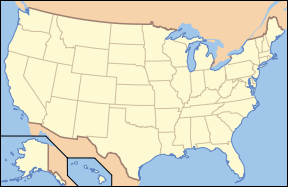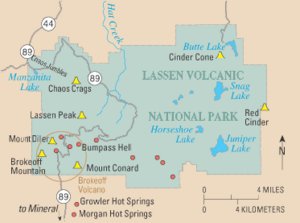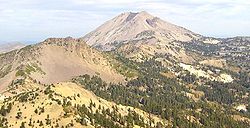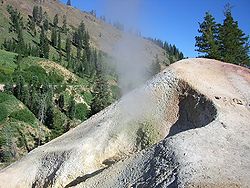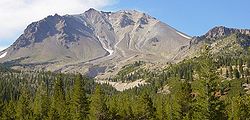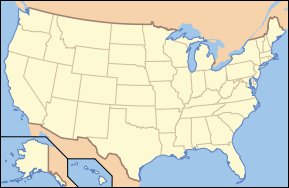Lassen Volcanic National Park
| Lassen Volcanic National Park | |
|---|---|
| IUCN Category II (National Park) | |
| | |
| Location: | Shasta, Lassen, Plumas, and Tehama Counties, California, USA |
| Nearest city: | Redding |
| Area: | 106,000 acres (42,900 ha) |
| Established: | August 9, 1916 |
| Visitation: | 395,057 (in 2007) |
| Governing body: | National Park Service |
Lassen Volcanic National Park is a United States National Park in north eastern California. The dominant feature of the park is Lassen Peak; the largest plug dome volcano in the world and the southern-most volcano in the Cascade Range. Lassen Volcanic National Park started as two separate national monuments designated by President Theodore Roosevelt in 1907: Cinder Cone National Monument and Lassen Peak National Monument.
The source of heat for volcanism in the Lassen area is subduction off the Northern California coast of the Gorda Plate diving below the North American Plate. The area surrounding Lassen Peak is still active with boiling mud pots, stinking fumaroles, and churning hot springs. Lassen Volcanic National Park is one of the few areas in the world where all four types of volcano can be found (plug dome, shield, cinder cone, and strato).
The park is accessible via State Routes SR 89 and SR 44. SR 89 passes north-south through the park, beginning at SR 36 to the south and ending at SR 44 to the north. SR 89 passes immediately adjacent the base of Lassen Peak.
There are a total of five vehicle entrances to the park: the north and south entrances of SR 89, and unpaved roads entering at Drakesbad and Juniper Lake in the south, and Butte Lake in the northeast. The Park can also be accessed by trails leading in from Caribou Wilderness to the east, as well as the Pacific Crest Trail, and two smaller trails leading in from Willow Lake and Little Willow Lake to the south.
A large lodge (the Lassen Chalet) with concession facilities formerly was located near the south-west entrance, but was demolished in 2005. A new, full-service visitor center is being constructed in the same location, with a planned completion date of 2008. Near the old lodge location was also located Lassen Ski Area, which ceased operation in 1992; all infrastructure has been removed.
Lassen Peak
Lassen Peak[1] (also known as Mount Lassen) is the southernmost active volcano in the Cascade Range. It is part of the Cascade Volcanic Arc which is an arc that stretches from northern California to southwestern British Columbia. Located in the Shasta Cascade region of Northern California, Lassen rises 2,000 feet (610 m) above the surrounding terrain and has a volume of half a cubic mile, making it one of the largest lava domes on Earth.[2] It was created on the destroyed northeastern flank of now gone Mount Tehama, a stratovolcano that was at least a thousand feet (300 m) higher than Lassen.
Lassen Peak has the distinction of being the only volcano in the Cascades other than Mount St. Helens to erupt during the 20th century. On May 22, 1915, an explosive eruption at Lassen Peak devastated nearby areas and rained volcanic ash as far away as 200 miles (320 km) to the east.[2] This explosion was the most powerful in a 1914–17 series of eruptions that were the last to occur in the Cascades before the 1980 eruption of Mount St. Helens in Washington. Lassen Volcanic National Park was created in Shasta County, California to preserve the devastated area and nearby volcanic wonders.
Unlike most lava domes, Lassen is topped by craters. In fact, a series of these craters exist around Lassen's summit, although two of these are now covered by solidified lava and sulfur deposits. Lassen is the largest of a group of more than 30 volcanic domes that have erupted over the past 300,000 years in the Lassen Volcanic Center.
Lassen is the southernmost in the chain of 18 large volcanic peaks that run from southwestern British Columbia to northern California. The peaks formed in the past 35 million years as the Juan De Fuca plate and the tiny Gorda plate to its south have been pulled under the overriding North American plate. As the oceanic crust in the Juan de Fuca plate melts under the pressure, it creates pools of lava that drive up the Cascade Range and power periodic eruptions in its volcanic peaks.
Roughly 27,000 years ago,[2] Lassen started to form as a mound-shaped dacite lava dome pushed its way through Tehama's destroyed north-eastern flank. As the lava dome pushed its way up, it shattered overlaying rock, which formed a blanket of angular talus around the emerging steep-sided volcano (it looked much like the nearby 1,100-year-old Chaos Crags). Lassen rose and reached its present height in a relatively short time, probably in as little as a few years.
From 25,000 to 18,000 years ago, during the last glacial period of the current ice age, Lassen’s shape was significantly altered by glacial erosion. For example, the bowl-shaped depression on the volcano’s northeastern flank, called a cirque, was eroded by a glacier that extended out 7 miles (11 km) from the dome.[2]
Lassen's most recent eruptive period started in 1914 and lasted for seven years (see below). The most powerful of these eruptions was a 1915 episode that sent ash and steam in a ten-kilometer-tall mushroom cloud, making it the largest recent eruption in the contiguous 48 U.S. states until the 1980 eruption of Mount St. Helens. The region remains geologically active, with mud pots, active fumaroles, and boiling water features, several of which are getting hotter. The area around Mount Lassen and nearby Mount Shasta are considered the most likely volcanoes in the Cascade Range to shift from dormancy to active eruptions.[3]
Human history
Native Americans have inhabited the area long before white settlers first saw Lassen. The natives knew that the peak was full of fire and water and thought that it would one day blow itself apart.[4]
White immigrants in the mid-19th century used Lassen Peak as a landmark on their trek to the fertile Sacramento Valley. One of the guides to these immigrants was a Danish blacksmith named Peter Lassen, who settled in Northern California in the 1830s. Lassen Peak was named after him.[4] Nobles Emigrant Trail was later cut through the park area and passed Cinder Cone and the Fantastic Lava Beds.
Inconsistent newspaper accounts reported by witnesses from 1850-1851 described seeing "fire thrown to a terrible height" and "burning lava running down the sides" in the area of Cinder Cone. As late as 1859 a witness reported seeing fire in the sky from a distance, attributing it to an eruption. Early geologists and volcanologists who studied the Cinder Cone concluded the last eruption occurred between 1675 and 1700. After the 1980 eruption of Mount St. Helens, the United States Geological Survey (USGS) began reassessing the potential risk of other active volcanic areas in the Cascade Range. Further study of Cinder Cone estimated the last eruption occurred between 1630 and 1670.
The Lassen area was first protected by being designated as the Lassen Peak Forest Preserve. Lassen Peak and Cinder Cone were later declared as U.S. National Monuments in May 1907 by President Theodore Roosevelt.[5]
Starting in May 1914 and lasting until 1921, a series of minor to major eruptions occurred on Lassen. These events created a new crater, and released lava and a great deal of ash. Fortunately, because of warnings, no one was killed, but several houses along area creeks were destroyed. Because of the eruptive activity, which continued through 1917, and the area's stark volcanic beauty, Lassen Peak, Cinder Cone and the area surrounding were declared a National Park on August 9 1916.[4]
The 29-mile (47 km) Main Park Road was constructed between 1925 and 1931, just 10 years after Lassen Peak erupted. Near Lassen Peak the road reaches 8,512 feet (2,594 m), making it the highest road in the Cascade Mountains. It is not unusual for 40 ft (12 m) of snow to accumulate on the road near Lake Helen and for patches of snow to last into July.
In 1974 the United States Park Service took the advice of the USGS and closed the visitor center and accommodations at Manzanita Lake. The Survey stated that these buildings would be in the way of a rockslide from Chaos Crags if an earthquake or eruption occurred in the area.[4] An aging seismograph station remains. However, a campground, store, and museum dedicated to Benjamin F. Loomis stands near Manzanita Lake, welcoming visitors who enter the park from the northwest entrance.
After the Mount St. Helens eruption, the USGS intensified its monitoring of active and potentially active volcanoes in the Cascade Range. Monitoring of the Lassen area includes periodic measurements of ground deformation and volcanic-gas emissions and continuous transmission of data from a local network of nine seismometers to USGS offices in Menlo Park, California.[6] Should indications of a significant increase in volcanic activity be detected, the USGS will immediately deploy scientists and specially designed portable monitoring instruments to evaluate the threat. In addition, the National Park Service (NPS) has developed an emergency response plan that would be activated to protect the public in the event of an impending eruption.
Geography and climate
The park is located near the northern end of the Sacramento Valley. The western part of the park features great lava pinnacles (huge mountains created by lava flows), jagged craters, and steaming sulphur vents. It is cut by glaciated canyons and is dotted and threaded by lakes and rushing clear streams.
The eastern part of the park is a vast lava plateau more than one mile (1.6 km) above sea level. Here are found small cinder cones (Fairfield Peak, Hat Mountain, and Crater Butte).[7] Forested with pine and fir, this area is studded with small lakes, but it boasts few streams. Warner Valley, marking the southern edge of the Lassen Plateau, features hot spring areas (Boiling Springs Lake, Devils Kitchen, and Terminal Geyser).[7] This forested, steep valley also has large meadows that have wildflowers in spring.
Lassen Peak is made of dacite, and is one of the world's largest plug dome volcanoes. It is also the southernmost non-extinct volcano of the Cascade Range (specifically, the Shasta Cascade part of the range). 10,457-foot (3,187 m) tall volcano sits on the north-east flank of the remains of Mount Tehama, a stratovolcano that was a thousand feet (305 m) higher than Lassen and 11 to 15 miles (18 to 24 km) wide at its base.[4] After emptying its throat and partially doing the same to its magma chamber in a series of eruptions, Tehama either collapsed into itself and formed a two-mile (3.2 km) wide caldera in the late Pleistocene or was simply eroded away with the help of acidic vapors that loosened and broke the rock, which was later carried away by glaciers.
On the other side of the present caldera is Brokeoff Mountain (9,235 feet or 2,815 m), which is an erosional remnant of Mount Tehama and the second highest peak in the park. Mount Conrad, Mount Diller, and Pilot Pinnacle are also remnant peaks around the caldera.
Sulphur Works is a geothermal area in between Lassen Peak and Brokeoff Mountain that is thought to mark an area near the center of Tehama's now-gone cone. Other geothermal areas in the caldera are Little Hot Springs Valley, Diamond Point (an old lava conduit), and Bumpass Hell (see Geothermal areas in Lassen Volcanic National Park).
The magma that fuels the volcanoes in the park is derived from subduction off the coast of Northern California.
Cinder Cone and the Fantastic Lava Beds, located about 10 miles (16 km) northeast of Lassen Peak, is a cinder cone volcano and associated lava flow field that last erupted about 1650. It created a series of basaltic andesite to andesite lava flows known as the Fantastic Lava Beds.
There are four shield volcanoes in the park; Mount Harkness (southwest corner of the park), Red Mountain (at south-central boundary), Prospect Peak (in northwest corner), and Raker Peak (north of Lassen Peak). All of these volcanoes are 7,000-8,400 feet (2,133-2,560 m) above sea level and each is topped by a cinder cone volcano.
During ice ages, glaciers have modified and helped to erode the older volcanoes in the park. The center of snow accumulation and therefore ice radiation was Lassen Peak, Red Mountain, and Raker Peak. These volcanoes thus show more glacial scarring than other volcanoes in the park.
Despite not having any glaciers currently, Lassen Peak does have 14 permanent snowfields ([1]).
Since the entire park is located at medium to high elevations, the park generally has cool-cold winters and warm summers below 7,500 feet (2,300 m). Above this elevation, the climate is harsh and cold, with cool summer temperatures. Precipitation within the park is high to very high due to a lack of a rain shadow from the Coast Ranges. The park gets more precipitation than anywhere in the Cascades south of the Three Sisters. Snowfall at the Lassen Peak Chalet at 6,700 feet (2,040 m) is around 430 inches (1,100 cm) despite facing east. Up around Lake Helen, at 8,200 feet (2,500 m) the snowfall is around 600-700 inches (1500 cm to 1800 cm), making it probably the snowiest place in California. In addition, Lake Helen gets more average snow accumulation than any other recording station located near a volcano in the Cascade range, with a maximum of 178 inches (450 cm).[8] Snowbanks persist year-round.
Geology
Formation of basement rocks
In the Cenozoic, uplifting and westward tilting of the Sierra Nevada along with extensive volcanism generated huge lahars (volcanic-derived mud flows) in the Pliocene which became the Tuscan Formation. This formation is not exposed anywhere in the national park but it is just below the surface in many areas.
Also in the Pliocene, basaltic flows erupted from vents and fissures in the southern part of the park. These and later flows covered increasingly large areas and built a lava plateau. In the later Pliocene and into the Pleistocene, these basaltic flows were covered by successive thick and fluid flows of andesite lava, which geologists call the Juniper lavas and the Twin Lakes lavas. The Twin Lakes lava is black, porphyritic and has abundant xenocrysts of quartz (see Cinder Cone).
Another group of andesite lava flows called the Flatiron, erupted during this time and covered the southwestern part of the park's area. The park by this time was a relatively featureless and large lava plain. Subsequently, the Eastern basalt flows erupted along the eastern boundary of what is now the park, forming low hills that were later eroded into rugged terrain.
Volcanoes rise
Pyroclastic eruptions then started to pile tephra into cones in the northern area of the park.
Mount Tehama (also known as Brokeoff Volcano) rose as a stratovolcano in the southeastern corner of the park during the Pleistocene. It was made of roughly alternating layers of andesitic lavas and tephra (volcanic ash, breccia, and pumice) with increasing amounts of tephra with elevation. At its height, Tehama was probably about 11,000 feet (3,400 m) high.
Approximately 350,000 years ago its cone collapsed into itself and formed a two-mile (3.2 km) wide caldera after it emptied its throat and partially did the same to its magma chamber in a series of eruptions. One of these eruptions occurred where Lassen Peak now stands, and consisted of fluid, black, glassy dacite, which formed a layer 1,500 feet (460 m) thick (outcroppings of which can be seen as columnar rock at Lassen's base).
During glacial periods (ice ages) of the present Wisconsinan glaciation, glaciers have modified and helped to erode the older volcanoes in the park, including the remains of Tehama. Many of these glacial features, deposits and scars, however, have been covered up by tephra and avalanches, or were destroyed by eruptions.
Roughly 27,000 years ago (older data gave an age of 18,000 years), Lassen Peak started to form as a dacite lava dome quickly pushed its way through Tehama's destroyed north-eastern flank. As the lava dome pushed its way up, it shattered overlaying rock, which formed a blanket of talus around the emerging volcano. Lassen rose and reached its present height in a relatively short time, probably in as little as a few years. Lassen Peak has also been partially eroded by Ice Age glaciers, at least one of which extended as much as 7 miles (11 km) from the volcano itself.
Since then, smaller dacite domes formed around Lassen. The largest of these, Chaos Crags, is just north of Lassen Peak. Phreatic (steam explosion) eruptions, dacite and andesite lava flows and cinder cone formation have persisted into modern times.
See also
- Lassen Peak
- Chaos Crags
- Geothermal areas in Lassen Volcanic National Park
- List of nationally protected areas of the United States
- Volcanic Legacy Scenic Byway
ReferencesISBN links support NWE through referral fees
- Geology of National Parks: Fifth Edition, Ann G. Harris, Esther Tuttle, Sherwood D., Tuttle (Iowa, Kendall/Hunt Publishing; 1997) ISBN 0-7872-5353-7
- Volcano Hazards of the Lassen Volcanic National Park Area, California, U.S. Geological Survey Fact Sheet 022-00, Online version 1.0 (adapted public domain text; accessed 25 September 2006)
Notes
- ↑ USGS GNIS: Lassen Peak
- ↑ 2.0 2.1 2.2 2.3 USGS: Eruptions of Lassen Peak, California, 1914 to 1917
- ↑ EO Newsroom
- ↑ 4.0 4.1 4.2 4.3 4.4 Geology of National Parks, p. 466.
- ↑ Geology of U.S. Parklands, p. 154.
- ↑ USGS: Volcano Hazards of the Lassen Volcanic National Park Area, California
- ↑ 7.0 7.1 "Geology Fieldnotes for Lassen Volcanic National Park California" (accessed 7 October 2006)
- ↑ Skimountaineer.com: Cascade Snow
External links
- Official National Park Service website
- Lassen Visitor Center
- USGS: Volcano Hazards of the Lassen Volcanic National Park Area
- USGS: Geology of Lassen Volcanic National Park
- Historic images of Lassen National Park, from the University of California
| National parks of the United States | |
|---|---|
| Acadia • American Samoa • Arches • Badlands • Big Bend • Biscayne • Black Canyon of the Gunnison • Bryce Canyon • Canyonlands • Capitol Reef • Carlsbad Caverns • Channel Islands • Congaree • Crater Lake • Cuyahoga Valley • Death Valley • Denali • Dry Tortugas • Everglades • Gates of the Arctic • Glacier • Glacier Bay • Grand Canyon • Grand Teton • Great Basin • Great Sand Dunes • Great Smoky Mountains • Guadalupe Mountains • Haleakala • Hawaii Volcanoes • Hot Springs • Isle Royale • Joshua Tree • Katmai • Kenai Fjords • Kings Canyon • Kobuk Valley • Lake Clark • Lassen Volcanic • Mammoth Cave • Mesa Verde • Mount Rainier • North Cascades • Olympic • Petrified Forest • Redwood • Rocky Mountain • Saguaro • Sequoia • Shenandoah • Theodore Roosevelt • Virgin Islands • Voyageurs • Wind Cave • Wrangell-St. Elias • Yellowstone • Yosemite • Zion List by: date established, state |
Credits
New World Encyclopedia writers and editors rewrote and completed the Wikipedia article in accordance with New World Encyclopedia standards. This article abides by terms of the Creative Commons CC-by-sa 3.0 License (CC-by-sa), which may be used and disseminated with proper attribution. Credit is due under the terms of this license that can reference both the New World Encyclopedia contributors and the selfless volunteer contributors of the Wikimedia Foundation. To cite this article click here for a list of acceptable citing formats.The history of earlier contributions by wikipedians is accessible to researchers here:
The history of this article since it was imported to New World Encyclopedia:
Note: Some restrictions may apply to use of individual images which are separately licensed.
